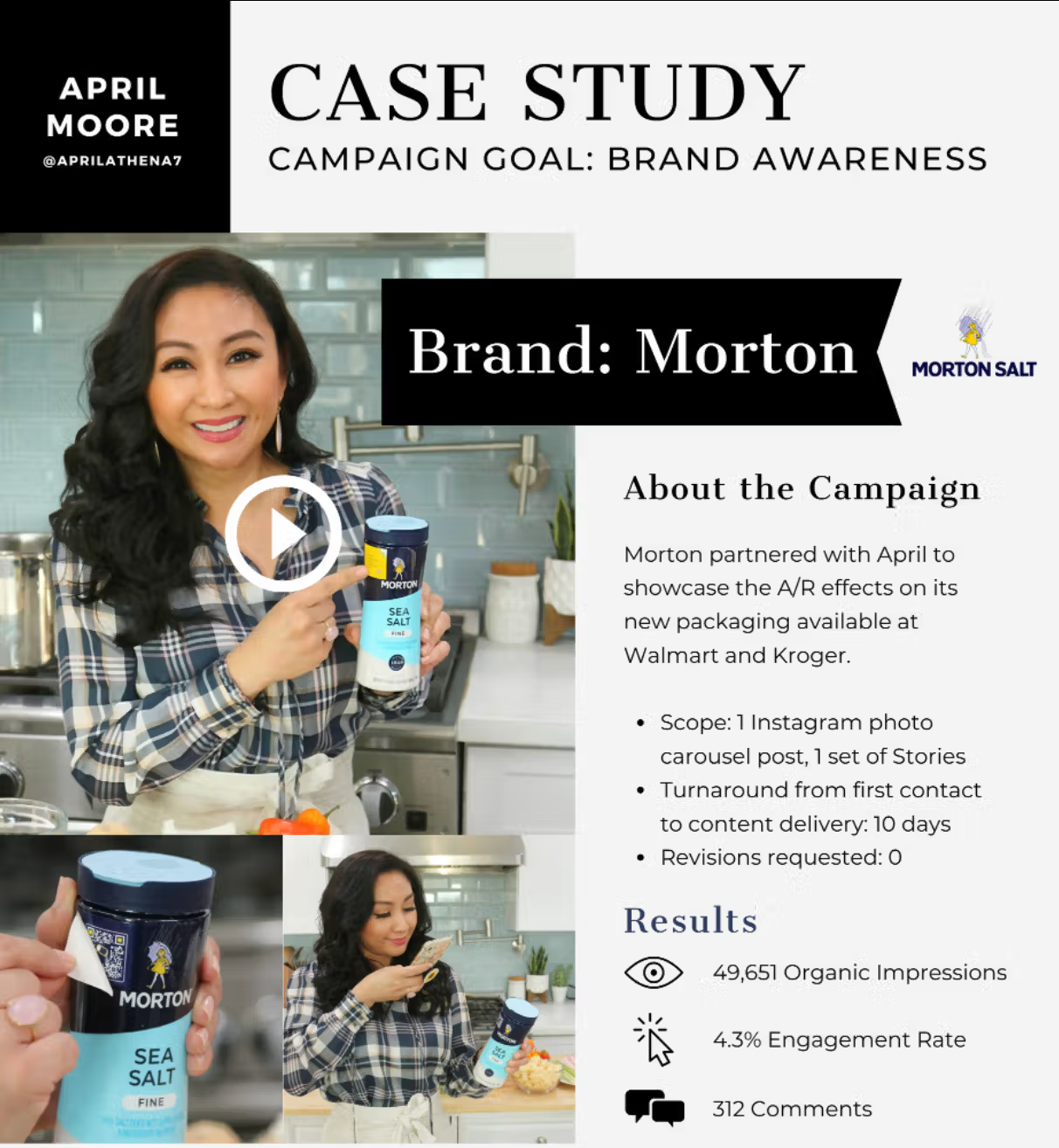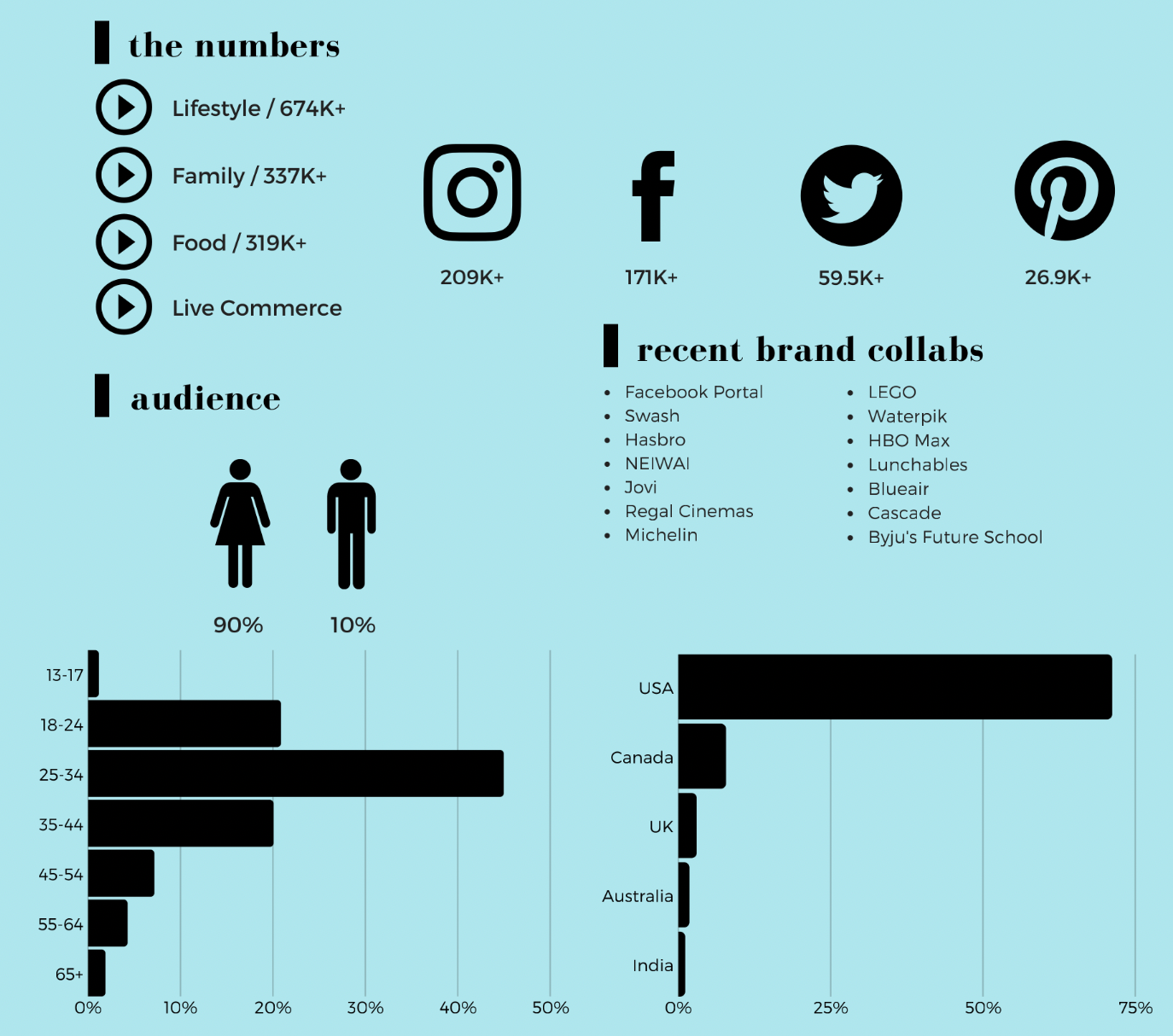Lydia Sweatt is a writer who loves balancing her article/blog time indoors with a healthy dose of nature. She bikes, hikes, and identifies edible plants along the way.
How to Make a Stunning Influencer Media Kit for Brand Deals
As an online influencer, it’s much easier to get brand deals when you have an impressive media kit.
But if you’ve never had to create one, two questions come to mind: What is a media kit for influencers? Do I need one?
The short answer is, yes, you do!
Stop Guessing. Start Growing.
Join 20M+ creators using vidIQ to get more views, subscribers, and success on YouTube.
For influencers, a media kit is a digital resume showing three things:
- The brand campaigns you’ve worked on
- The results you’ve produced for brands
- Glowing testimonials to back it all up

So whether you’re creating on YouTube, Instagram, TikTok, or Twitch, you need a media kit to get better deals. It helps you stand out from other influencers and answer a brand’s most pressing questions:
- Does this creator speak to our target audience?
- Have they worked on this type of campaign before?
- What results did they achieve for other brands?
We’ll show you how to create an influencer media kit in this post. We’ll also share advice from Justin Moore (sponsorship coach at CreatorWizard), plus pages from a sample influencer media kit.
What to Include In Your Influencer Media Kit (Most to Least Important)
Overall, your media kit needs five sections:
- Cover page
- Brand partnerships
- Testimonials
- Your bio
- Your social media stats
1. Cover Page
The first page of your media kit will be the cover itself.
This is where you’ll introduce yourself to brands and share basic information they might need:
- The title of the document (likely just “media kit”)
- A photo of you
- Your name
- Your title (beauty influencer, gaming creator, etc.)
- Your contact information (an email address will do)
For the cover photo, try to pick one that represents you and your niche. For example, family and lifestyle influencer April Moore used a photo of herself, her husband Justin Moore, and two kids. She creates from a space of motherhood and togetherness, and you can tell just by looking at the cover.

2. Previous Brand Partnerships
The next thing to show in your media kit is campaigns you’ve worked on in the past. According to Moore, this is what brands want to see more than anything else – not your bio or the number of followers you have. They just want to feel confident in your abilities.
“Oftentimes, [brands have] already made their decision,” Moore says. “They’re excited about working with you, and now they just need a little reinforcement that hiring you is the right decision.”
To make this section shine, contact the brand and ask about its campaign goals. With that information, you can showcase partnerships representing the brand's vision.
For example, there are three types of campaigns:
- Conversion-focused: driving sales, app downloads, coupon redemptions, etc.
- Content repurposing: creating diverse assets for the brand, such as TikTok videos that can become advertisements
- Brand awareness: spreading the word about the brand or its latest product
And that brings us to our second influencer media kit example. Take a look at how April Moore presented her brand awareness campaign with Morton Salt:

But what if the brand is interested in a different outcome, such as conversions or collecting content? In that case, you’ll have to show different metrics.
Option 1: Present a conversion campaign where you turned viewers into customers for the brand. Provide relevant data, such as newsletter sign-ups, app downloads, online purchases, etc.
Option 2: Present a content-repurposing campaign where you made assets for a brand. Those could be videos for the company’s website, Instagram, Facebook, etc.
What to Do If You Haven’t Worked With Brands
Are you chasing your first brand deal on social media? You won’t have any sponsored posts to show off in your media kit, but don’t worry; you can still impress brands and get hired. All you need is a micro-influencer media kit (or nano influencer).
- Buy a product you love and make content about it. If the content performs well, this proves your ability to influence people and drive engagement. Put that in your media kit.
- Showcase a piece of content that could have been sponsored. Do you have a video or image that's centered around a brand and also performed well? Add that to your media kit to help brands envision what you would create for them.
3. Testimonials from Brands
When you finish a fun campaign, it’s smart to ask for personal reviews you can use as testimonials. Were you easy to work with? Extremely responsive? Good at producing high-quality content?
If you read a testimonial that makes you smile, add it to your media kit – right after all the facts, figures, and percentages of the campaign itself.
You see, numbers are extremely important to brands – but so is likability. They want to feel comfortable working with you, so showing that other companies would work with you again is a huge benefit. It proves that you’d be a great partner.
Check out these awesome testimonials from April Moore’s media kit:

4. A Short Bio
In this section, describe your personal brand in more detail. Which interests or hobbies play a role in shaping your content? What ideas and beliefs do you share with your audience? Infuse your personality and let brands know who you are.
This section doesn’t have to be long. Your bio can be just five sentences or a series of quick bullet points.
Or, you can do both, as shown here in April Moore's kit:

And here’s another tip: Fight the urge to put your bio on the cover page of your media kit.
“Basically, take that about me section that everyone puts on page one, and put that to the end,” Moore says. “The number one thing brands care about when they’re requesting your media kit is case studies and testimonials.”
5. Your Social Media Channels, Content Performance, and Audience Demographics
By this point, brands are reaching the end of your media kit. Now there’s just one more thing to address: Do you and the brand share the same target audience? In the world of influencer marketing, brands want to speak to their core consumers – not just anyone on the internet.
1. Go to the analytics dashboard for each of your social media channels, and find your audience demographics (the core characteristics of your followers). Then add the following information to your media kit:
- The age range of your audience, broken down by percentage
- The percentage of male and female viewers
- The physical location of your viewers, broken down by country
For example, here’s the gender, age, and location breakdown for viewers on the vidIQ YouTube channel. This is the information brands want to see.


2. Next, show your follower/subscriber count for each platform. You don't need a humongous following to land a brand deal, but it's important to include for some campaigns – especially brand awareness.
3. Add your monthly performance for each social platform, such as:
- Views
- Impressions
- Likes
- Engagement ratio
The metrics you use will depend on where you create content. Monthly views are important for YouTube creators, but Instagram influencers might show likes and engagement ratio, too. Pick the data that matters most for your social platforms.
And finally, here’s an example of how it all comes together. At the end of April Moore’s media kit, you’ll see her social media channels, subscriber/follower counts, and overall audience demographics.

FAQ: Extra Things to Know About Media Kits
Need extra help crafting your media kit? Here’s a brief Q&A with Justin Moore, sponsorship and brand deals coach.
Q: How long should an influencer’s media kit be?
Moore: There’s no minimum or maximum number of pages to put in your media kit. Still, you have to be realistic. A brand probably doesn’t want to read 20 or more pages – just enough to confirm that you’re right for the campaign.
If they can get that assurance by reading one case study, that’s all they’re going to look at. Put as many pages as you need to illustrate your abilities.
Q: How do I tailor my media kit for specific brands?
Moore: No matter what type of brand comes at you, have a case study to illustrate that you can solve the pain point or campaign they’re looking to run.
To do this, you need a media kit that covers every content vertical you explore and all the major campaign types. So if you’re a fashion and lifestyle creator, you need six case studies in your media kit:
- Two conversion case studies: one for lifestyle, one for fashion
- Two content-repurposing case studies: one for lifestyle, one for fashion
- Two brand awareness case studies: one for lifestyle, one for fashion
Then it’s just a matter of swapping out pages as needed to send the most relevant version of your media kit. It doesn't take that long.
Q: Should I include a pricing page in my media kit?
Moore: If there’s anything you get from this post, you should take that page of your media kit and drag it into the trash. Every deal you do with a brand will be different. You need to understand the goal of the campaign before you put a proposal together.
For example, if the brand comes to you and says, “Our goal is to get a bunch of great content from you that we can embed on our website,” you wouldn’t turn around and say, “Here’s my pricing for YouTube videos and Instagram posts.” The brand just told you they don’t care about that. Maybe what you pitch them are five to ten 30-second videos that you don’t even post on your social media.
Q: Where can I find influencer media kit templates?
Moore: Canva!
Of course, your media kit is just one piece of the brand deal puzzle.
Here are 10 pitching mistakes to avoid when trying to get brand deals (especially on YouTube).
20k+ 5 Star Reviews
Ready to put this into action?
Use vidIQ to find your next video idea, pick better keywords, and optimize every upload.






